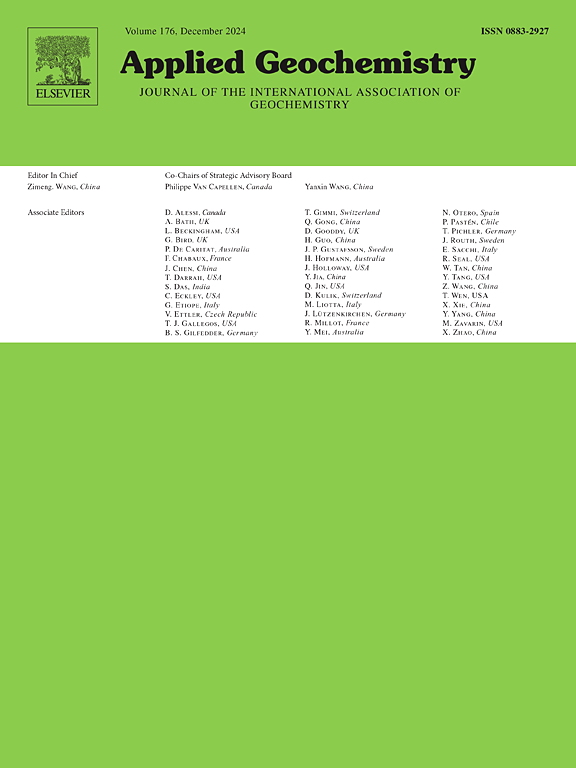Uranium(VI) retention by calcium (alumino)silicate hydrates – Impact of temperature and ionic strength
IF 3.4
3区 地球科学
Q1 GEOCHEMISTRY & GEOPHYSICS
引用次数: 0
Abstract
Calcium aluminosilicate hydrates (C-A-S-H) are the main hydration products of cement formulations with Al-rich additives such as blast furnace slags, fly ashes or calcined clays. We studied systematically the effect of Al substitution on both the structure of C-A-S-H phases and their U(VI) retention properties in comparison to C-S-H phases. To represent the different stages of cement degradation, three series of samples were synthesized, which included samples with Ca/Si molar ratios of 0.8, 1.2 and 1.6 and different Al/Si molar ratios of 0, 0.06 and 0.18 for each series. Furthermore, the impact of synthesis temperature (room temperature, 100 °C, 200 °C) on the C-(A-)S-H structure was studied. The U(VI) retention, studied either by sorption experiments or by direct synthesis of U(VI)-containing C-(A-)S-H phases, was found to be strong with log Rd between 4.9 and 5.6. Structural characteristics of the cementitious phases were obtained from powder X-ray diffraction (XRD) as well as 29Si and 27Al solid-state magic angle spinning nuclear magnetic resonance (SS MAS NMR) spectroscopy. AlO4 tetrahedra were identified to occupy bridging positions of the silicate chains, thereby increasing the mean chain length and providing additional sorption sites for U(VI) at room temperature. Elevated temperatures during solid phase formation, however, lead to a stronger cross-linking of the silicate chains with the appearance of neoformed crystalline phases. Luminescence spectroscopy was applied to characterize the U(VI) binding. Various U(VI) species (interlayer or surface sorbed) are formed in different proportions, depending on the composition and structure of the C-(A-)S-H phases, which are partly affected by elevated temperatures. To simulate salinity changes of the pore water, the effect of enhanced ionic strengths and the presence of carbonate on the stability of the U(VI) retention by the C-(A-)S-H phases was studied by sorption and leaching experiments over extended timescales of up to 6 months. For C-(A-)S-H phases previously exposed to temperatures of up to 100 °C, the effect of medium ionic strengths (up to 2.6 M) on U(VI) retention was insignificant.

钙(铝)硅酸盐水合物对铀(ⅵ)的保留。温度和离子强度的影响
钙铝硅酸盐水合物(C-A-S-H)是含富铝添加剂(如高炉炉渣、粉煤灰或煅烧粘土)的水泥配方的主要水化产物。我们系统地研究了Al取代对C-A-S-H相结构和U(VI)保留性能的影响,并与C-S-H相进行了比较。为了代表水泥降解的不同阶段,我们合成了三个系列的样品,其中Ca/Si摩尔比分别为0.8、1.2和1.6,Al/Si摩尔比分别为0、0.06和0.18。此外,还研究了合成温度(室温、100℃、200℃)对C-(A-)S-H结构的影响。通过吸附实验和直接合成含U(VI)的C-(A-)S-H相研究,发现当log Rd在4.9 ~ 5.6之间时,U(VI)保留较强。通过粉末x射线衍射(XRD)和29Si、27Al固体魔角自旋核磁共振(SS MAS NMR)谱分析获得了胶凝相的结构特征。发现AlO4四面体占据了硅酸盐链的桥接位置,从而增加了平均链长,并在室温下为U(VI)提供了额外的吸附位点。然而,在固相形成过程中,温度升高导致硅酸盐链的交联更强,并出现新形成的结晶相。用发光光谱法对U(VI)结合进行了表征。根据C-(A-)S-H相的组成和结构,不同的U(VI)种类(层间或表面吸附)以不同的比例形成,这部分受温度升高的影响。为了模拟孔隙水的盐度变化,通过长达6个月的吸附和浸出实验,研究了离子强度增强和碳酸盐的存在对C-(A-)S-H相保留U(VI)稳定性的影响。对于先前暴露于高达100℃温度下的C-(A-)S-H相,介质离子强度(高达2.6 M)对U(VI)保留的影响不显著。
本文章由计算机程序翻译,如有差异,请以英文原文为准。
求助全文
约1分钟内获得全文
求助全文
来源期刊

Applied Geochemistry
地学-地球化学与地球物理
CiteScore
6.10
自引率
8.80%
发文量
272
审稿时长
65 days
期刊介绍:
Applied Geochemistry is an international journal devoted to publication of original research papers, rapid research communications and selected review papers in geochemistry and urban geochemistry which have some practical application to an aspect of human endeavour, such as the preservation of the environment, health, waste disposal and the search for resources. Papers on applications of inorganic, organic and isotope geochemistry and geochemical processes are therefore welcome provided they meet the main criterion. Spatial and temporal monitoring case studies are only of interest to our international readership if they present new ideas of broad application.
Topics covered include: (1) Environmental geochemistry (including natural and anthropogenic aspects, and protection and remediation strategies); (2) Hydrogeochemistry (surface and groundwater); (3) Medical (urban) geochemistry; (4) The search for energy resources (in particular unconventional oil and gas or emerging metal resources); (5) Energy exploitation (in particular geothermal energy and CCS); (6) Upgrading of energy and mineral resources where there is a direct geochemical application; and (7) Waste disposal, including nuclear waste disposal.
 求助内容:
求助内容: 应助结果提醒方式:
应助结果提醒方式:


